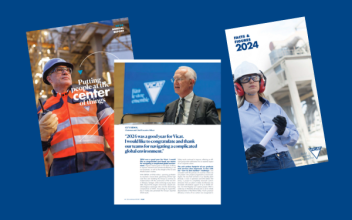CimentAlgue : harnessing CO2 and waste heat in cement plants to produce microalgae
Vicat is working together with AlgoSource Technologies, TotalEnergies and the Université de Nantes to accelerate the development of microalgae production using CO2 and waste heat.
The CimentAlgue industrial research project is aimed at harnessing CO2 and waste heat from the manufacture of cement to produce microalgae. The project’s demonstrator will be set up at Vicat’s Montalieu-Vercieu cement plant. The project received financial support from France’s Environment and Energy Management Agency (ADEME) for the 2014 BIP call for proposals (BIP: bioresources, industry, performance). By harnessing industrial waste flows for use as essential raw materials for the development of micro-organisms, this innovative process helps reduce atmospheric emissions of CO2.
FYI: microalgae consume 5 to 10 times more CO2 per square meter than terrestrial plants.
How the demonstrator works
- - Microalgae crops are farmed in greenhouses to facilitate temperature regulation and to protect them from dust, wind, and any contaminants (bacteria, other microalgae, protozoa, etc.) that might be introduced by external factors.
- - The waste heat taken directly from the cement kiln is used to heat water for the pond heating systems.
- - CO2 is taken from the cement kiln exhaust stack.
- - Several farming technologies have been selected: open and closed ‘raceway’ ponds, a tubular photobioreactor, and an ‘AlgoFilm’ thin-layer photobioreactor (PBR).
Life-size demonstrator for real progress
The technology used for this research was validated previously, at a smaller scale, through trials with the AlgoSolis platform run by the University of Nantes and France’s National Scientific Research Center (CNRS). The 800-m² CimentAlgue demonstrator set up at Vicat’s Montalieu-Vercieu cement plant will achieve the following:
- - meet microalgae farming targets at a representative scale (capacity of around 1 metric ton of dried microalgae per year);
- - optimize parameters for full mastery of microalgae growth;
- - measure the CO2 balance of industrial symbiosis very precisely;
- - determine rules for the design rating of other microalgae farming installations for other sites/industries;
- - perform ‘life-size trials’ on different microalgae farming methods and demonstrate their economic and industrial viability; and
- - test the compatibility of this exhaust-fume recovery process with its application in the field of biofuels (from technical and regulatory points of view).
What is a tubular photobioreactor?
The microalgae grown with the tubular photobioreactor in this project is arthrospira platensis, commonly called spirulina. With the tubular PBR, all the parameters affecting microalgal development (light, temperature, CO2, nutrients) can be closely controlled to achieve optimum growth.

Testing different strains of microalgae, such as spirulina for instance, will lead to the development of products consistent with markets adapted to the industrial scale of cement plants. The lipids, proteins and sugars that can be extracted from them can be used in animal feed, as plant biostimulants, or to make bio-based materials, etc. Strains of oleaginous microalgae with potentially high growth rates will also be tested with a view to producing third-generation biofuels.
DOWNLOAD THE CIMENTALGUE PRESS RELEASE (in French only)



